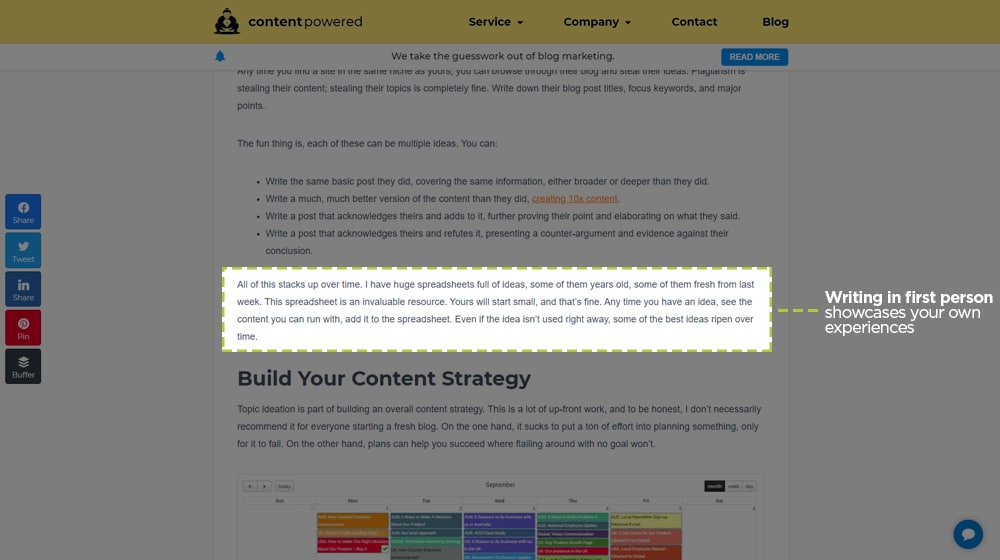Should You Blog in The First, Second, or Third Point of View?

One question about blogging that every blogger picks an answer to, but few of them give critical thought to, is the choice of point of view. Point of view comes in three forms; first, second, and third person. I've read some interesting things about a fourth-person point of view, but grammatically speaking, it doesn't exist.
Which one you choose has an impact on your writing, your branding, and your engagement with your audience. There's no right or wrong answer, merely a personal choice, but you do need to be consistent. It's not a good idea to bounce between "me" and "we" in your articles.
Let's get started!
 30 Second Summary
30 Second Summary
You'll need to pick between three points of view when you write: first, second or third person. Each choice affects how readers connect with you. If you write in first person ("I"), you'll build closer bonds with readers who share your experiences. When you use second person ("you"), you'll connect directly with readers and work well for tutorials. Third person ("they") works best for news and PR but can feel distant. You should match your choice to your goals and stick with it throughout your content.
Explaining Point of View
First, for those of you who haven't thought about your English classes in a decade or two, let's go over what point of view is. Point of view is the perspective from which you're writing. Can you identify which one I'm writing in right now? Here are some examples to help you out.
1. First Person:
"When I'm writing my blog posts, I don't often pay too much attention to the choice of pronouns I'm using. I write about my own experiences, what I do with my blogging, and how I can help you improve your blogging."
2. Second Person:
"When you're writing your blog posts, you should probably give some attention to the pronouns you decide to use. You want to write about your experiences, but you want to personalize it to your audience, and help guide them towards blogging success."
3. Third Person:
"Bloggers are often faced with the choice of determining which pronouns they should use in their posts. A blogger will want to write about their experiences, but may also desire to showcase examples and customizations that can personalize content for their audience."
You've probably seen all three of these on the web because they're all commonly in use.
Another factor to consider is the singular or plural points of view. This applies to first-person writing, primarily, though it may have an impact on how you address your users in the second person. To rewrite the first-person writing example, in plural:
"When we're writing our blog posts, we don't often pay too much attention to the choice of pronouns we use. We write about our own experiences, what we do with our blogging, and how we can help you improve your blog."
I tend to write in the first-person singular point of view here on this blog, because it's my blog, and I'm giving advice and sharing my experiences. When I write for clients, I usually write in the first-person plural point of view, under the assumption that it's the business who is writing rather than an individual, but I can customize for the client's needs. As with any aspect of writing, a talented writer can shift between them as necessary for a project.
A common question that I hear is "is there a point of view better than the others?" or "which point of view should I write my content in?".
It's a good question. Before we get into that, let's talk about the impact of each one, and how users typically respond to them.
The Impact of Point of View
So, what is the impact of your choice of POV? It all comes down to how you appear to your readers and how much of a relationship they can build with you.
First Person
Writing in the first person showcases your own experiences. It's a personal, intimate form of writing, even when pluralized. Your readers will tend to have a closer level of engagement with you and will feel like they get to know you and how you work. It's a big way that small businesses can compete against larger entities; no one believes the CEO of Nike has a personal hand in the marketing, product development, or manufacturing of their products, but a small bespoke cobbler can write in the first-person and come across as genuine.

One bit of trouble – and why a lot of my writing comes across as second-person writing until you notice the occasional dips into first-person writing – is the intimacy. First-person writing is excellent for building intimacy centered around a shared experience, but what if you don't share that experience? If I'm writing about my experiences living in a tropical vista as if they're commonplace, but you've never left the snowy northern reaches of Mongolia, you'll find it hard to empathize with what I have to say.
You end up building a more dedicated, narrower audience of more engaged people, but you lose a lot of people who don't share your experiences or perspectives, and who find it difficult to put themselves in your shoes. Unfortunately, there are a lot of people who struggle to empathize with others, which leads to a lot of conflict around the world. You end up writing for the wrong crowd or addressing problems that aren't a concern to them.
Blogging in the first-person point of view is fine for blogs where adding a personal touch and building a personal brand are your primary goals. It's also good for biographical and lived experience content, as well as memoirs and some kinds of fiction. Unfortunately, it's not always the best for certain kinds of blog writing.
First-person writing is also the point of view of choice for calls to action. Think about a simple CTA for claiming a free trial.

Which of these are you more likely to click on?
- "Claim Your Free Trial"
- "Claim My Free Trial"
Looking at them side by side, you might not feel like they're all that different. Studies show, however, that the first-person word "my" tends to be much more engaging and gets more clicks.
Second Person
Writing in the second person is a focus on you and your perspectives, experiences, needs, and desires. A lot of my articles come across as second-person writing until I dip into the pronouns, and I like it that way. By focusing on my audience, I can showcase how I know their needs and can offer them solutions.

This writing style is the ideal perspective for two main situations.
1. First, it's great for tutorials and instructional guides. "First you need to do X, and then you need to do Y. You can then do Z, as long as A has been done and you can access B to do it." Instructive posts, guides, tutorials, and so on can be written in the first-person as well, but they tend to be a little clunkier and have a different vibe. Specifically, a tutorial written in the first person comes across as sharing a unique experience, whereas the same tutorial written in the second person is a guide to letting you have the experience.
2. Second, it's the ideal method for a lot of blog post writing. Why? The reader feels like you're talking to them directly. You feel like I'm talking to you right now, don't you? That's because I am.
This stems from a common marketing trick called user personas. I have a series of "character sheets" for typical representative members of my audience. My largest audience tends to be people who are small business owners who are looking into blogging, but who may not be convinced that blogging is a good idea. A secondary audience is people who know they should be blogging, and are looking into learning more about the intricacies of how to blog.

Both of those types of people will be interested in specific kinds of content, but those types of content don't overlap too much. Each post I write picks one of those buyer personas and focuses on writing for them. Dave, the small business owner, will be most interested in a marketing topic. Susan, the blogger, will be most interested in something like, say, a technical guide on choosing a point of view in writing. I write directly to you, that hypothetical Susan, and thus my content is more personalized and intimate.
The primary benefit to using buyer personas in this way is to recognize and address the specific needs and desires of that category of your audience. I know my hypothetical blogger audience wants to know more technical details of writing, so I address them.
Third Person
Writing in the third person tends to be a lot more detached. You used to see it a lot in the early days of the internet because the people writing for the web were largely academicians who were used to following AP Style Guides or writing for an audience of other academics.

The philosophy back then was that writing in an impartial, detached way lent you an air of authority. It's not me telling you something, it's "The Word Of God Delivering Information To An Audience". By stating everything as fact, by removing the personal, content is thought to be more authoritative.
This lasted for a while before people realized that reading academic papers wasn't something they wanted to do in their spare time, and more casual uses of writing picked up steam. These days, third-person writing tends to be viewed as impartial, stuffy, and withdrawn.
There are good reasons to use third-person writing. The first is in fiction writing. Most books you read will tend to be in the third person, either with a limited perspective (wherein you can only view the thoughts and actions of the perspective character) or omniscient (where you can see the thoughts of many characters in a scene.)
Online, the primary use for third-person writing is for news and PR content. Press releases like this one tend to be written from a third-person perspective because they are meant to be someone else writing about the brand or business involved, even though we all know the brand writes their press releases. News, as well, is generally written in the third person, because the reporter is not a participant in the scene, merely reporting on it.
Which Point of View Should You Use?
All three POVs have their uses, so the question becomes, which one should you use for your blog? In my view, it comes down to a few key factors.

1. Who is the person writing and publishing the content? Content Powered is my business and my blog, and I write from my perspective, with my own experiences and anecdotes. I focus on how my experiences can help you, though, which makes my writing more of a hybrid first/second POV, or more of a second-person POV across the board, depending on how you define it.
If your blog is your blog, you can use first-person writing and use it to build a personal brand in addition to your actual business brand.
If, on the other hand, you have a team of people writing for you, or your writing represents your business as a whole, you're more likely going to want to write in a second-person POV. You might also dip into first-person writing from time to time, but explicitly in the plural, not the singular. This is how I tend to write for my clients unless otherwise instructed.
Large businesses might be tempted to go with the "Word of God" authority of the third-person point of view, but this is usually a mistake. More often, they want to go with second-person writing instead. Third-person writing is for reporters, journalists, and news agencies more than anyone else.
2. How large is the entity creating the blog? This factor is a little less impactful than you might think. A small business might have a hard time pulling off the perspective of authority necessary to write in the third person. A huge multinational, meanwhile, might have a difficult time convincing their audience that their first-person POV is anything other than a committee.
3. How do you want to engage with your audience? I tend to focus on building a personal brand and personal representation of myself, because I'm the person you talk to when you call this company, I'm the one doing the sales calls, I'm the one responding to emails, and I'm the one you build a relationship with when you contract my company. I want you to feel like you know me (at least a little bit) when you reach out to say hello. I want you to trust me and trust that I know what I'm talking about.
If you're not trying to build that personal brand, second-person writing tends to be the way to go. You want to talk directly to your audience, and you want to show that you understand them and what they need. You may also want to use plural POV because it's your brand that understands your users, not you personally.
Of course, all three POVs can work. The key, as with most elements of blogging, is to be consistent with what you're doing. Just be careful that you don't slip into the dreaded and forbidden fourth person, lest you suffer the consequences.
How do you prefer to write your blog posts? Do you like how I write my articles in the first-person point of view, or do you prefer writing in the second or third-person? Let me know in the comments below! I reply to every comment I get on my articles and would love to hear your thoughts.



 30 Second Summary
30 Second Summary



Comments